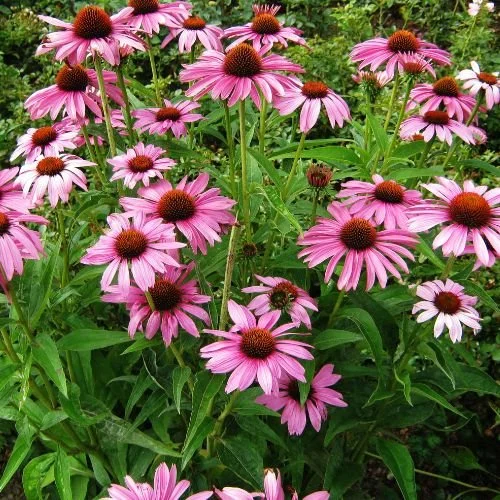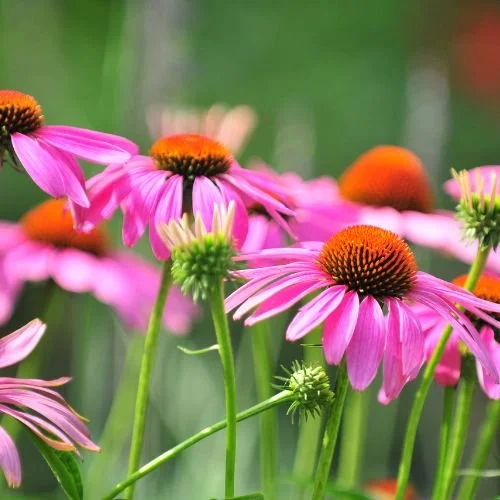

Organic Echinacea seeds
Echinacea (Echinacea purpurea)
Echinacea, commonly known as Purple Coneflower, is a hardy, long-blooming perennial native to central and eastern North America. A member of the daisy family (Asteraceae), this iconic wildflower is prized for its ornamental value, ecological benefits, and a long tradition of medicinal use. With its striking purple-pink petals and prominent cone-shaped centers, echinacea is a pollinator magnet and a resilient addition to gardens, meadows, and permaculture systems.
Cover Plant Benefits:
Pollinator Powerhouse:
Echinacea’s vibrant blooms are rich in nectar and pollen, making them a favorite among bees, butterflies (especially monarchs), hummingbirds, and other beneficial pollinators. Their prolonged blooming period (typically midsummer to early fall) provides a critical nectar source during a time when fewer wildflowers are in bloom.
Biodiversity Booster:
Attracts a wide variety of beneficial insects, including lacewings and parasitic wasps, supporting natural pest control and enhancing garden biodiversity.
Low Maintenance:
Once established, echinacea thrives with little care. It's drought-tolerant, disease-resistant, and not particularly attractive to deer or rabbits—making it ideal for naturalistic or low-input gardens.
Soil Health Support:
With a deep taproot system, echinacea helps break up compacted soils and draw nutrients from deeper layers, aiding in soil structure and fertility. It also stabilizes soil and can help reduce erosion on sloped sites.
Seed Resource for Wildlife:
In late summer and fall, the seed heads become a valuable food source for songbirds, particularly goldfinches.
Health Benefits
Echinacea has been used for centuries in Native American medicine and is widely studied today for its immune-modulating properties. Most commonly used parts include the roots, flowers, and leaves.
Immune Support:
Best known for its role in supporting the immune system, echinacea is widely used as a herbal remedy to reduce the severity and duration of colds and respiratory infections.
Anti-inflammatory:
Contains active compounds such as alkamides, caffeic acid derivatives, and polysaccharides that exhibit anti-inflammatory effects, potentially useful for inflammatory skin and joint conditions.
Antioxidant Properties:
Rich in antioxidants like flavonoids and rosmarinic acid that protect the body from oxidative stress and may support overall health.
Antimicrobial:
Exhibits antimicrobial and antiviral activity, contributing to its traditional use in wound care, infections, and upper respiratory support.
Topical Uses:
Used in salves and poultices for minor wounds, insect bites, burns, and skin irritations. The anti-inflammatory and antibacterial properties help soothe the skin and promote healing.
Lymphatic System Support:
Traditionally used to stimulate lymphatic flow and detoxification processes, aiding in recovery during illness.
Adaptogen-Like Qualities (Emerging Research):
Some studies suggest echinacea may have mild adaptogenic properties, helping the body adapt to stress and regulate immune function over time.
Planting Instructions:
When to Plant:
Sow seeds in early spring or late fall. Fall sowing mimics natural stratification conditions and can result in stronger germination rates.
Light Requirements:
Prefers full sun but tolerates light shade. Full sun promotes stronger flowering and sturdier plants.
Soil:
Thrives in well-drained soil. Tolerates poor, sandy, or rocky soils once established. Avoid heavy clay or poorly drained locations.
Sowing Seeds:
Cold Stratification:
Requires a period of cold stratification for 30–60 days to break dormancy. This can be achieved by fall sowing outdoors or by refrigerating seeds in moist sand or vermiculite before spring planting.
Surface or Lightly Covered Sow:
Press seeds lightly into the soil surface or cover with a thin layer (about 1/8 inch) of fine soil. Requires light for germination.
Keep Moist Until Germination:
Germination typically takes 10–20 days with consistent moisture and warm temperatures (65–75°F).
Transplants or Divisions:
Space 12–18 inches apart. Echinacea will spread over time and can be divided every 3–4 years in spring or fall to maintain vigor and propagate new plants.
Maintenance:
Deadhead to prolong blooming, or leave seed heads for wildlife and winter interest. Cut back dead stems in early spring. Drought-tolerant once established but appreciates occasional deep watering in prolonged dry periods. Minimal fertilization needed.
Echinacea (Echinacea purpurea)
Echinacea, commonly known as Purple Coneflower, is a hardy, long-blooming perennial native to central and eastern North America. A member of the daisy family (Asteraceae), this iconic wildflower is prized for its ornamental value, ecological benefits, and a long tradition of medicinal use. With its striking purple-pink petals and prominent cone-shaped centers, echinacea is a pollinator magnet and a resilient addition to gardens, meadows, and permaculture systems.
Cover Plant Benefits:
Pollinator Powerhouse:
Echinacea’s vibrant blooms are rich in nectar and pollen, making them a favorite among bees, butterflies (especially monarchs), hummingbirds, and other beneficial pollinators. Their prolonged blooming period (typically midsummer to early fall) provides a critical nectar source during a time when fewer wildflowers are in bloom.
Biodiversity Booster:
Attracts a wide variety of beneficial insects, including lacewings and parasitic wasps, supporting natural pest control and enhancing garden biodiversity.
Low Maintenance:
Once established, echinacea thrives with little care. It's drought-tolerant, disease-resistant, and not particularly attractive to deer or rabbits—making it ideal for naturalistic or low-input gardens.
Soil Health Support:
With a deep taproot system, echinacea helps break up compacted soils and draw nutrients from deeper layers, aiding in soil structure and fertility. It also stabilizes soil and can help reduce erosion on sloped sites.
Seed Resource for Wildlife:
In late summer and fall, the seed heads become a valuable food source for songbirds, particularly goldfinches.
Health Benefits
Echinacea has been used for centuries in Native American medicine and is widely studied today for its immune-modulating properties. Most commonly used parts include the roots, flowers, and leaves.
Immune Support:
Best known for its role in supporting the immune system, echinacea is widely used as a herbal remedy to reduce the severity and duration of colds and respiratory infections.
Anti-inflammatory:
Contains active compounds such as alkamides, caffeic acid derivatives, and polysaccharides that exhibit anti-inflammatory effects, potentially useful for inflammatory skin and joint conditions.
Antioxidant Properties:
Rich in antioxidants like flavonoids and rosmarinic acid that protect the body from oxidative stress and may support overall health.
Antimicrobial:
Exhibits antimicrobial and antiviral activity, contributing to its traditional use in wound care, infections, and upper respiratory support.
Topical Uses:
Used in salves and poultices for minor wounds, insect bites, burns, and skin irritations. The anti-inflammatory and antibacterial properties help soothe the skin and promote healing.
Lymphatic System Support:
Traditionally used to stimulate lymphatic flow and detoxification processes, aiding in recovery during illness.
Adaptogen-Like Qualities (Emerging Research):
Some studies suggest echinacea may have mild adaptogenic properties, helping the body adapt to stress and regulate immune function over time.
Planting Instructions:
When to Plant:
Sow seeds in early spring or late fall. Fall sowing mimics natural stratification conditions and can result in stronger germination rates.
Light Requirements:
Prefers full sun but tolerates light shade. Full sun promotes stronger flowering and sturdier plants.
Soil:
Thrives in well-drained soil. Tolerates poor, sandy, or rocky soils once established. Avoid heavy clay or poorly drained locations.
Sowing Seeds:
Cold Stratification:
Requires a period of cold stratification for 30–60 days to break dormancy. This can be achieved by fall sowing outdoors or by refrigerating seeds in moist sand or vermiculite before spring planting.
Surface or Lightly Covered Sow:
Press seeds lightly into the soil surface or cover with a thin layer (about 1/8 inch) of fine soil. Requires light for germination.
Keep Moist Until Germination:
Germination typically takes 10–20 days with consistent moisture and warm temperatures (65–75°F).
Transplants or Divisions:
Space 12–18 inches apart. Echinacea will spread over time and can be divided every 3–4 years in spring or fall to maintain vigor and propagate new plants.
Maintenance:
Deadhead to prolong blooming, or leave seed heads for wildlife and winter interest. Cut back dead stems in early spring. Drought-tolerant once established but appreciates occasional deep watering in prolonged dry periods. Minimal fertilization needed.